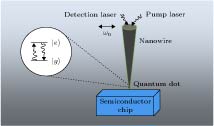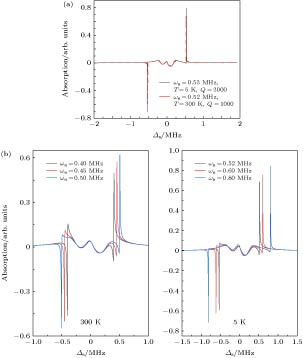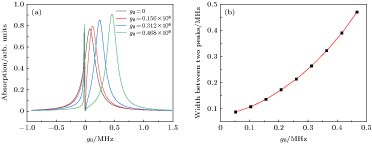-
提出一种复合量子点-纳米机械振子系统, 该系统以半导体芯片为基底, 量子点嵌入倒置半导体圆锥纳米线的底端, 通过光学抽运-探测技术来驱动量子点-纳米机械振子系统, 研究该系统中的相干光学特性. 通过探测吸收谱给出确定机械振子频率和量子点-纳米机械振子耦合强度的全光学方法. 此外, 基于该系统理论上提出一种在室温下的全光学质量传感方案. 通过测量吸收谱中附着在机械振子上纳米颗粒的质量引起的共振频移, 可间接测出额外纳米颗粒的质量. 与先前的复合纳米机械振子系统相比, 系统中的激子-声子耦合强度的数值可与振子频率比拟, 可实现超强耦合, 有利于相干光学特性的观测, 在超高精度及高分辨率质量传感器件方面有着潜在应用.Nanomechanical oscillators have not only the advantages of extremely small mass and volume, but also high vibration frequency and quality factor, so they are widely used in the field of sensors. In recent years, nanomechanical oscillators comprised of graphene nanoribbons, carbon nanotubes, molybdenum disulfide and other materials have been used to make mass sensors. Great progress has been made in the application of mass sensing, but the measurement environment is limited to ultra-low temperature. Presented in this paper is a hybrid quantum dot-nanomechanical resonator (QD-NR) system which is based on semiconductor chips with quantum dots embedded at the bottom of inverted semiconductor conical nanowires. The system has the advantages of high integration level, full optical interface and low temperature compatibility. In addition, it has a coupling strength, a frequency as large as the vibration frequency of the mechanical oscillator, and a long spin life, which provides the possibility of realizing the quantum unassembled readout of a single spin at room temperature. We investigate the coherent optical properties with the optical pump-probe scheme, and an all-optical mean for determining the resonator frequency and the coupling strength of the QD and NR is presented with the absorption spectrum under different parameter regimes. We set the frequency of the pump light to be equal to the exciton frequency and scan the frequency range of the detection light, and then two sharp peaks will appear in the absorption spectrum of the probe light, and the sharp peak is for the frequency of the mechanical oscillator. Moreover, the coupling strength can be obtained from the linear relationship between the peak splitting width and the coupling strength in the absorption spectrum. Further, we put forward a room temperature mass sensing based on the hybrid QD-NR system, and the frequency shift caused by additional nanoparticles can be directly measured with the absorption spectrum, and then the mass of extra nanoparticles can be determined. Comparing with the previous nanomechanical oscillator, the exciton-phonon coupling strength is very strong in the system and can reach the ultra-strong coupling, which is advantageous for observing the coherent optical properties and reaching high precision and resolution mass sensing. In this system, the mass responsivity can reach. The scheme is expected to be applied to mass measurement of some biomolecules, isotopes and other materials, and also be widely used in other fields at a nanogram level.
-
Keywords:
- quantum dots /
- nanomechanical resonators /
- mass sensing
[1] Li J J, Zhu K D 2013 Phys. Rep. 525 223
 Google Scholar
Google Scholar
[2] Yeo I, De Assis P L, Gloppe A, Dupont-Ferrier E, Verlot P, Malik N S, Dupuy E, Claudon J, Gérard J M, Auffèves A, Nogues G, Seidelin S, Poizat J P, Arcizet O, Richard M 2014 Nat. Nanotech. 9 106
 Google Scholar
Google Scholar
[3] Treutlein P 2014 Nat. Nanotech. 9 99
 Google Scholar
Google Scholar
[4] Arcizet O, Jacques V, Siria A, Poncharal P, Vincent P, Seidelin S 2011 Nat. Phys. 7 879
 Google Scholar
Google Scholar
[5] Kolkowitz S, Jayich A C B, Unterreithmeier Q P, Bennett S D, Rabl P, Harris J G E, Lukin M D 2012 Science 335 1603
 Google Scholar
Google Scholar
[6] Unruh W G 1978 Phys. Rev. D 18 1764
 Google Scholar
Google Scholar
[7] Auffeves A, Richard M 2014 Phys. Rev. A 90 023818
 Google Scholar
Google Scholar
[8] 陈雪, 刘晓威, 张可烨, 袁春华, 张卫平 2015 物理学报 64 164211
 Google Scholar
Google Scholar
Chen X, Liu X W, Zhang K Y, Yuan C H, Zhang W P 2015 Acta Phys. Sin. 64 164211
 Google Scholar
Google Scholar
[9] Lecocq F, Clark J B, Simmonds R W, Aumentado J, Teufel J D 2015 Phys. Rev. X 5 041037
[10] 钟文学, 王一平, 程广玲 2015 光学学报 35 0827001
 Google Scholar
Google Scholar
Zhong W X, Wang Y P, Cheng G L 2015 Acta Opt. Sin. 35 0827001
 Google Scholar
Google Scholar
[11] Ekinci K L, Yang Y T, Roukes M L 2004 J. Appl. Phys. 95 2682
 Google Scholar
Google Scholar
[12] Li Z Z, Ouyang S H, Lam C H, You J Q 2012 Phys. Rev. B 85 235420
 Google Scholar
Google Scholar
[13] Liao J Q, Kuang L M 2008 Eur. Phys. J. B 63 79
 Google Scholar
Google Scholar
[14] Boisen A 2009 Nat. Nanotech. 4 404
 Google Scholar
Google Scholar
[15] 陈华俊, 米贤武 2011 物理学报 60 124206
 Google Scholar
Google Scholar
Chen H J, Mi X W 2011 Acta Phys. Sin. 60 124206
 Google Scholar
Google Scholar
[16] 李金金, 宾文, 朱卡的 2014 科学通报 59 1907
 Google Scholar
Google Scholar
Li J J, Bin W, Zhu K D 2014 Chin. Sci. Bull. 59 1907
 Google Scholar
Google Scholar
[17] 陈华俊, 方贤文, 陈昌兆, 李洋 2016 物理学报 65 194205
 Google Scholar
Google Scholar
Chen H J, Fang X W, Chen C Z, Li Y 2016 Acta Phys. Sin. 65 194205
 Google Scholar
Google Scholar
[18] Xu X, Sun B, Berman P R, Steel D G, Bracker A S, Gammon D, Sham L J 2008 Nat. Phys. 4 692
 Google Scholar
Google Scholar
[19] Liu J, Zhu K D 2018 Photon. Res. 6 867
 Google Scholar
Google Scholar
[20] Imoto N, Haus H A, Yamamoto Y 1985 Phys. Rev. A 32 2287
 Google Scholar
Google Scholar
[21] Pontin A, Bonaldi M, Borrielli A, Marconi L, Marino F, Pandraud G, Prodi G A, Sarro P M, Serra E, Marin F 2018 Phys. Rev. A 97 033833
 Google Scholar
Google Scholar
[22] Chen H J, Zhu K D 2014 J. Opt. Soc. Am. B 31 1684
 Google Scholar
Google Scholar
[23] Chen H J, Chen C Z, Li Y, Fang X W, Tang X D 2016 Sci. Rep. 6 36600
 Google Scholar
Google Scholar
[24] Hanay M S, Kelber S, Naik A K, Chi D, Hentz S, Bullard E C, Colinet E, Duraffourg L, Roukes M L 2012 Nat. Nanotechnol. 7 602
 Google Scholar
Google Scholar
[25] Li J J, Zhu K D 2009 Appl. Phys. Lett. 94 063116
 Google Scholar
Google Scholar
[26] He Y 2017 Nanotechnology 28 255203
 Google Scholar
Google Scholar
-
图 2 (a)不同温度下探测吸收与探测光-激子失谐量
${\varDelta _{\rm{s}}}$ 的函数关系; (b)室温(300 K)和低温(5 K)下, 不同的振子频率时探测吸收与探测光-激子失谐量${\varDelta _{\rm{s}}}$ 的函数关系; 图中参数为${\varGamma _1} =0.1\;{\rm{ MHz}}$ ,${\varGamma _2} =0.05\;{\rm{ MHz}}$ ,${\varOmega _0^2} =0.01\;{\rm{ (MHz}}{{\rm{)}}^2}$ ,${\varDelta _0} = 0$ ,${g_0} = 0.5{\omega _{\rm{n}}}$ Fig. 2. (a) Function relationship between detection absorption and detection light-exciton detuning
${\varDelta _{\rm{s}}}$ at different temperatures; (b) the functional relationship between the detected absorption and the detector-exciton detuning${\varDelta _{\rm{s}}}$ under different oscillator frequencies at room temperature and low temperature.${\varGamma _1} =0.1\;{\rm{ MHz}}$ ,${\varGamma _2} =0.05\;{\rm{ MHz}}$ ,${\varOmega _0^2} =0.01\;{\rm{ (MHz}}{{\rm{)}}^2}$ ,${\varDelta _0} \!=\! 0$ ,${g_0} \!=\! 0.5{\omega _{\rm{n}}} $ 图 3 (a)
${\varDelta _0} = {\omega _{\rm{n}}}$ 时不同耦合强度得到的探测吸收谱; (b)吸收光谱中两峰的劈裂宽度与耦合强度的关系; 两图中参数均为${\varGamma _1} =0.2\;{\rm{ MHz}}$ ,${\varGamma _2} =0.1\;{\rm{ MHz}}$ ,${\omega _{\rm{n}}} =0.52\;{\rm{ MHz}}$ ,${\varOmega _0} =0.15\;{\rm{ MHz}}$ ,$Q = 1000$ Fig. 3. (a) Detection absorption spectra obtained at different coupling intensities with
${\varDelta _0} = {\omega _{\rm{n}}}$ ; (b) the relationship between the splitting width of the two peaks in the absorption spectrum and the coupling strength. The parameters in both figures are${\varGamma _1} =0.2\;{\rm{ MHz}}$ ,${\varGamma _2} =0.1\;{\rm{ MHz}}$ ,${\omega _{\rm{n}}} =0.52\;{\rm{ MHz}}$ ,${\varOmega _0} =0.15\;{\rm{ MHz}}$ ,$Q = 1000$ .图 4 (a)振子上外加纳米颗粒时的吸收谱, 图中
${\varGamma _1} =0.1\;{\rm{ MHz}}$ ,${\varGamma _2} =0.05\;{\rm{ MHz}}$ ,$\varOmega _0^2 =0.01\;{\rm{ (MHz}}{{\rm{)}}^2}$ ,${\varDelta _0} = 0$ ,${\omega _{\rm{n}}} =0.52\;{\rm{ MHz}}$ ,${g_0} = 0.5{\omega _{\rm{n}}}$ ,$Q = 1000$ ; (b)外加纳米颗粒个数与振子频移的关系Fig. 4. (a) Absorption spectra when nanoparticles are added to the oscillator, where
${\varGamma _1} =0.1\;{\rm{ MHz}}$ ,${\varGamma _2} =0.05\;{\rm{ MHz}}$ ,$\varOmega _0^2 =0.01\;{\rm{ (MHz}}{{\rm{)}}^2}$ ,${\varDelta _0} = 0$ ,${\omega _{\rm{n}}} =0.52 \;{\rm{MHz}}$ ,${g_0} = 0.5{\omega _{\rm{n}}}$ ,$Q = 1000$ ; (b) the relationship between the number of added nanoparticles and the oscillator frequency shift. -
[1] Li J J, Zhu K D 2013 Phys. Rep. 525 223
 Google Scholar
Google Scholar
[2] Yeo I, De Assis P L, Gloppe A, Dupont-Ferrier E, Verlot P, Malik N S, Dupuy E, Claudon J, Gérard J M, Auffèves A, Nogues G, Seidelin S, Poizat J P, Arcizet O, Richard M 2014 Nat. Nanotech. 9 106
 Google Scholar
Google Scholar
[3] Treutlein P 2014 Nat. Nanotech. 9 99
 Google Scholar
Google Scholar
[4] Arcizet O, Jacques V, Siria A, Poncharal P, Vincent P, Seidelin S 2011 Nat. Phys. 7 879
 Google Scholar
Google Scholar
[5] Kolkowitz S, Jayich A C B, Unterreithmeier Q P, Bennett S D, Rabl P, Harris J G E, Lukin M D 2012 Science 335 1603
 Google Scholar
Google Scholar
[6] Unruh W G 1978 Phys. Rev. D 18 1764
 Google Scholar
Google Scholar
[7] Auffeves A, Richard M 2014 Phys. Rev. A 90 023818
 Google Scholar
Google Scholar
[8] 陈雪, 刘晓威, 张可烨, 袁春华, 张卫平 2015 物理学报 64 164211
 Google Scholar
Google Scholar
Chen X, Liu X W, Zhang K Y, Yuan C H, Zhang W P 2015 Acta Phys. Sin. 64 164211
 Google Scholar
Google Scholar
[9] Lecocq F, Clark J B, Simmonds R W, Aumentado J, Teufel J D 2015 Phys. Rev. X 5 041037
[10] 钟文学, 王一平, 程广玲 2015 光学学报 35 0827001
 Google Scholar
Google Scholar
Zhong W X, Wang Y P, Cheng G L 2015 Acta Opt. Sin. 35 0827001
 Google Scholar
Google Scholar
[11] Ekinci K L, Yang Y T, Roukes M L 2004 J. Appl. Phys. 95 2682
 Google Scholar
Google Scholar
[12] Li Z Z, Ouyang S H, Lam C H, You J Q 2012 Phys. Rev. B 85 235420
 Google Scholar
Google Scholar
[13] Liao J Q, Kuang L M 2008 Eur. Phys. J. B 63 79
 Google Scholar
Google Scholar
[14] Boisen A 2009 Nat. Nanotech. 4 404
 Google Scholar
Google Scholar
[15] 陈华俊, 米贤武 2011 物理学报 60 124206
 Google Scholar
Google Scholar
Chen H J, Mi X W 2011 Acta Phys. Sin. 60 124206
 Google Scholar
Google Scholar
[16] 李金金, 宾文, 朱卡的 2014 科学通报 59 1907
 Google Scholar
Google Scholar
Li J J, Bin W, Zhu K D 2014 Chin. Sci. Bull. 59 1907
 Google Scholar
Google Scholar
[17] 陈华俊, 方贤文, 陈昌兆, 李洋 2016 物理学报 65 194205
 Google Scholar
Google Scholar
Chen H J, Fang X W, Chen C Z, Li Y 2016 Acta Phys. Sin. 65 194205
 Google Scholar
Google Scholar
[18] Xu X, Sun B, Berman P R, Steel D G, Bracker A S, Gammon D, Sham L J 2008 Nat. Phys. 4 692
 Google Scholar
Google Scholar
[19] Liu J, Zhu K D 2018 Photon. Res. 6 867
 Google Scholar
Google Scholar
[20] Imoto N, Haus H A, Yamamoto Y 1985 Phys. Rev. A 32 2287
 Google Scholar
Google Scholar
[21] Pontin A, Bonaldi M, Borrielli A, Marconi L, Marino F, Pandraud G, Prodi G A, Sarro P M, Serra E, Marin F 2018 Phys. Rev. A 97 033833
 Google Scholar
Google Scholar
[22] Chen H J, Zhu K D 2014 J. Opt. Soc. Am. B 31 1684
 Google Scholar
Google Scholar
[23] Chen H J, Chen C Z, Li Y, Fang X W, Tang X D 2016 Sci. Rep. 6 36600
 Google Scholar
Google Scholar
[24] Hanay M S, Kelber S, Naik A K, Chi D, Hentz S, Bullard E C, Colinet E, Duraffourg L, Roukes M L 2012 Nat. Nanotechnol. 7 602
 Google Scholar
Google Scholar
[25] Li J J, Zhu K D 2009 Appl. Phys. Lett. 94 063116
 Google Scholar
Google Scholar
[26] He Y 2017 Nanotechnology 28 255203
 Google Scholar
Google Scholar
计量
- 文章访问数: 11990
- PDF下载量: 112
- 被引次数: 0














 下载:
下载:











































